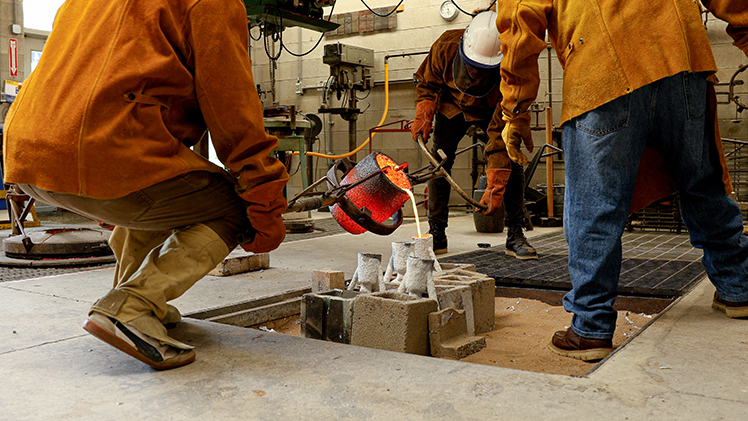The University of Toledo fired up its foundry to assist an artist collective in dropping digital medallions into the smartphones of visitors to the Toledo Museum of Art.
The Queen’s Medallion, a bronze work emblazoned with the stately profile of an imagined Ethiopian Queen, is on display in “House of Yatreda” through Sunday, Nov. 10. In line with the vision for the Toledo Museum of Art’s Digital Artist in Residence program, visitors to the immersive installation can also use their smartphones to claim a digital version of the medallion as a non-fungible token (NFT).

Artists forge a bronze medallion inside the foundry in UToledo’s Center for Sculptural Studies. Photo courtesy of the Toledo Museum of Art.
“University foundries are few and far between anymore,” said Brian Carpenter, a senior lecturer in the UToledo Department of Art who worked with the Ethiopian family artist collective Yatreda : ያጥሬዳ to cast the medallion in UToledo’s Center for Sculptural Studies, a standalone facility near the art museum and the adjacent UToledo Center for the Visual Arts. “It’s a unique resource that we can offer to our students and our community, and we welcome opportunities to collaborate on projects like The Queen’s Medallion.”
Yatreda came to Carpenter’s attention as the art museum’s 2024 Digital Artist in Residence. Established by the museum in 2023, the Digital Artist in Residence program invites international and community artists to merge artistic practices with digital technologies, supporting their growth within the digital and generative art space.
“The resident artists gain access to the resources that we have available,” said Sophie Ong, assistant director of strategic initiatives at the Toledo Museum of Art. “That includes our partners, which in this case meant the UToledo Department of Art.”
The Toledo Museum of Art and the UToledo Department Art enjoy a close relationship, as demonstrated in the exhibitions that art students curate at the museum using works from its collection — a process that requires close collaboration with museum staff.
The most recent student-curated exhibit, “Generational Echoes: Privilege, Power and the Transmission of Knowledge,” ran from April to July.

The Queen’s Medallion, 2024. Yatreda | ያጥሬዳ. (Ethiopian, established 2021) Bronze model for non-fungible token (NFT). Courtesy of the artist. Photo courtesy of the Toledo Museum of Art.
When Yatreda approached Ong about their idea for The Queen’s Medallion, Ong said it was natural to connect them with Carpenter, who coordinates the three-dimensional art offerings that UToledo primarily offers at its Center for Sculptural Studies.
Like the nearby Center for Visual Arts, which houses the UToledo Department of Art, the Center for Sculptural Studies is designed by the world-renowned architect Frank Gehry. In addition to the foundry, it houses ceramic, sculpture and wood studio classrooms.
Carpenter worked with Yatreda to cast four variations of the medallion in wax, then forge them in bronze, resulting in the work on display in “House of Yatreda.”
The installation, located within the exhibition “Ethiopia at the Crossroads,” uses digital artwork and interactive experiences to imagine the journey of the ancient queen depicted on the medallion and her entourage as they traverse kingdoms and navigate the mystical forests in between.
The medallion is presented as a key part of this lore.
When claimed by visitors as a digital artwork, it serves as a diplomatic passport presented by the monarch herself to provide safe passage from ancient Ethiopia to Toledo.
“We’re always thinking about the integration of physical and digital,” Ong said. “The Queen’s Medallion blends both traditional and digital artforms, combining the expertise of Brian and Yatreda. The feedback from visitors has been overwhelmingly positive.”
“House of Yatreda,” an immersive installation inside the exhibition “Ethiopia at the Crossroads,” is on display at the Toledo Museum of Art, 2445 Monroe St., Toledo, through Sunday, Nov. 10. Exhibition tickets are $10. For more information, go to the Toledo Museum of Art website.